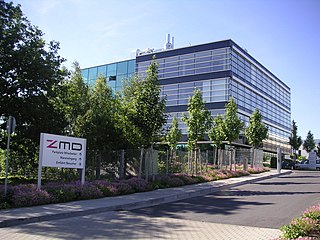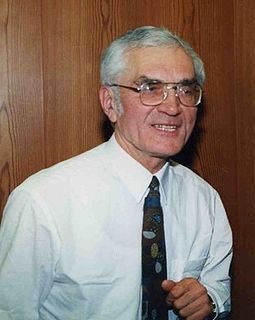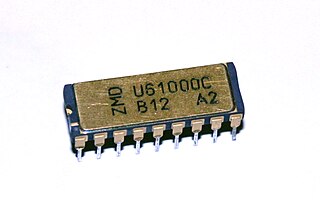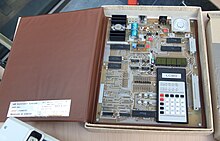
VEB Kombinat Robotron was the biggest East German electronics manufacturer. It was based in Dresden and employed 68,000 people (1989). It produced personal computers, SM EVM minicomputers, the ESER mainframe computers, several computer peripherals as well as home computers, radios, television sets and other items including a kleingebäckpresse.
Pro Electron or EECA is the European type designation and registration system for active components.

The Galaksija was a build-it-yourself computer designed by Voja Antonić. It was featured in the special edition Računari u vašoj kući of a popular eponymous science magazine, published late December 1983 in Belgrade, Yugoslavia. Kits were available but not required as it could be built entirely out of standard off-the-shelf parts. It was later also available in complete form.

The KC 85 were models of microcomputers built in East Germany, first in 1984 by VEB Robotron and later by VEB Mikroelektronik "Wilhelm Pieck" Mühlhausen.

The Zilog Z8 is a microcontroller architecture, originally introduced in 1979, which today also includes the Z8 Encore!, eZ8 Encore!, eZ8 Encore! XP, and eZ8 Encore! MC families.
The National Prize of the German Democratic Republic was an award of the German Democratic Republic (GDR) given out in three different classes for scientific, artistic, and other meritorious achievement. With scientific achievements, it was often given to entire research groups rather than individual scientists.

Zentrum Mikroelektronik Dresden (ZMD) was regarded as the heart of East Germany's microelectronics research in the 1980s as well as its most advanced integrated circuit manufacturer. Together with TU Dresden and VEB Spurenmetalle Freiberg, ZMD formed the foundation for Silicon Saxony, a cluster of microelectronics companies that came to include new fabs by Siemens and AMD.

The U880 is an 8-bit microprocessor that was manufactured by VEB Mikroelektronik "Karl Marx" Erfurt in the German Democratic Republic. Production of the U880 started in 1980 at VEB Funkwerk Erfurt. The U880 is an unlicensed clone of the Zilog Z80 microprocessor, also supporting illegal opcodes and bugs, except for very minor differences like not setting the CY flag for the OUTI command.

The MRB Z1013 was an East German Single-board computer produced by VEB Robotron Riesa which was primarily intended for private use and educational institutions. It was powered by a U880 processor and sold together with a membrane keyboard. Initially, the kit was equipped with 16-KByte DRAM, which was later replaced by a 64-KByte version.

The NDR Klein Computer, abbreviated NKC, was a do-it-yourself computer project from the early 1980s developed by Rolf-Dieter Klein (RDK) and Joachim Arendt. In 1984, the computer was featured in the educational television series NDR-Klein-Computer for NDR-Schulfernsehen. It was also broadcast on the computer television show ComputerTreff on the Bavarian TV network Bayerisches Fernsehen (BFS).
Volker Kempe is a German scientist, manager and entrepreneur.

The P8000 is a microcomputer system developed in 1987 by the VEB Elektro-Apparate-Werke Berlin-Treptow „Friedrich Ebert“ (EAW) in the German Democratic Republic. It consisted of an 8-bit and a 16-bit microprocessor and a Winchester disk controller. It was intended as a universal programming and development system for multi-user/multi-task applications. The initial list price of the P8000 was 172,125 East German marks.

Michael Roth was a German engineer and professor of automation, specializing in microprocessor technology, computer science and sociology as well as philosophy of science. He was one of the pioneers in the area of computer engineering in Germany.

The Radio-86RK is a build-it-yourself home computer designed in the Soviet Union. It was featured in the popular Radio magazine for radio hams and electronics hobbyists in 1986. The letters RK in the title stands for the words Radio ham's Computer. Design of the computer was published in a series of articles describing its logical structure, electrical circuitry, drawings of printed circuit boards and firmware. The computer could be built entirely out of standard off-the-shelf parts. Later it was also available in a kit form as well as fully assembled form.

VEB Kombinat Mikroelektronik Erfurt was an important manufacturer of active electronic components in East Germany. It should not be confused with the more well-known VEB Kombinat Robotron Dresden which used integrated circuits from Kombinat Mikroelektronik in its computers. The trademark RFT was used for components from Kombinat Mikroelektronik, as well as for most electronic products from East Germany.

East Germany was one of the leading computer producers in the Eastern Bloc as purchases of higher technologies from the West were under various embargoes. A program of illegal purchases, copying and reverse engineering of Western examples was established, after which GDR sold these computers to COMECON countries. Under the rule of Erich Honecker electronics, microelectronics and data processing industries grew at average 11.4% in the 1970s and 12.9% during the 1980s.

The BSS 01, also known as RFT TV-Spiel or simply TV-Spiel, is a dedicated first-generation home video game console that was released in 1980 or 1981 only in East Germany. It was manufactured between 1979 and 1980 by VEB Halbleiterwerk Frankfurt (Oder) and is credited the only video game console that was released in East Germany. Due to its high price, it rarely succeeded in private households and mostly delivered to youth centers, leisure and educational institutions.
The electronics industry in the Socialist Republic of Romania was characterized by stronger ties to Western Europe when compared to other countries in the Eastern Bloc due to the drive of the Romanian leadership towards greater autonomy from the Soviet Union.

VEB Halbleiterwerk Frankfurt (Oder) was the largest manufacturer of semiconductor devices in the German Democratic Republic. In 1989, HFO produced 110 million integrated circuits, 9.7 million transistors, and 150 million transistor chips. Despite this, HFO did not rise to prominence like Zentrum Mikroelektronik Dresden or VEB Mikroelektronik "Karl Marx" Erfurt. Also unlike Zentrum Mikroelektronik Dresden and VEB Mikroelektronik "Karl Marx" Erfurt, HFO did not survive long after German Reunification.
The UC compander system is a noise reduction system for vinyl records, aiming at highest playback compatibility even without corresponding UC expander.

















